CBSE Previous Year Question Papers Class 12 Physics 2012 Outside Delhi
CBSE Previous Year Question Papers Class 12 Physics 2012 Outside Delhi Set-I
Question 1.
Two wires of equal length, one of copper and the other of manganin have the same resistance. Which wire is thicker ? [1]
Answer :
Since the resistivity of alloy is greater than the resistivity of its constituents. We have resistivity of manganin greater than resistivity of copper metal.
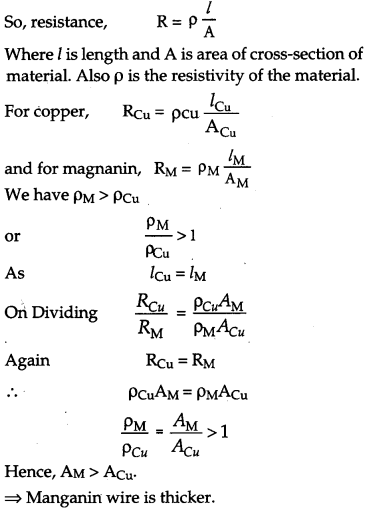
Question 2.
What are the directions of electric and magnetic field vectors relative to each other and relative to the direction of propagation of electromagnetic waves ? [1]
Answer :
Since electromagnetic waves are transverse in nature. We have electric and magnetic fields associated with an electromagnetic wave perpendicular to each other and perpendicular to the direction of propagation of electromagnetic waves.
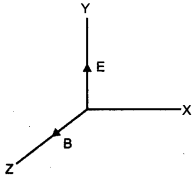
Let the direction of electric field and magnetic field is along Y and Z-axis then the direction of propagation of EM waves will be along positive X-axis.
Question 3.
How does the angular separation between fringes in single-slit diffraction experiment change when the distance of separation between the slit and screen is doubled ? [1]
Answer :
We know angular separation is given as
\(\theta=\frac{\beta}{D}=\frac{\frac{D \lambda}{d}}{D}=\frac{\lambda}{d}\)
Since θ is independent of D i.e., the distance of separation between the screen and the slit, so when D is doubled, angular separation would remain same.
Question 4.
A bar magnet is moved in the direction indicated by the arrow between two coils PQ and CD. Predict the directions of induced current in each coil.
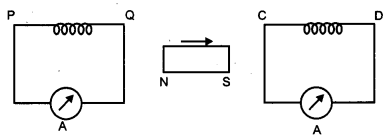
Answer :
According to Lenz’s, law the polarity of the induced emf is such that it opposes the change in magnetic flux responsible for its production.
Since, North pole of bar magnet is receding away from the coil so the right end of the coil will develop South pole i.e., induced current as seen from the left end will be anticlockwise.
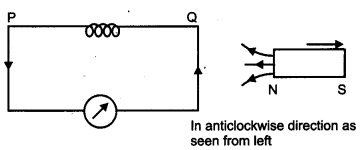
Again, since South pole is pushing towards the second coil so the left end of the coil will develop South pole in order to repel it and decrease the flux i.e., induced current as seen from the left end will be clockwise.
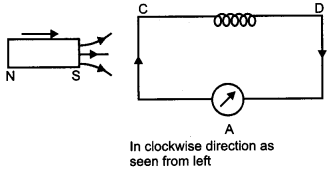
Question 5.
For the same value of angle of incidence, the angles of refraction in three media A, B and C are 15°, 25° and 35° respectively. In which medium would the velocity of light be minimum ? [1]
Answer :
As light travels from a rarer to denser medium it bends towards the normal as its speed decreases. So, if the bending is more, the speed of the light would be less in that medium, compared to other media. As the angle of refraction is measured with respect to the normal, the ray making the least angle of refraction would bend more and the speed of light would be minimum in that case. So, the correct option is medium A where refracting angle is 15°.
Question 6.
A proton and an electron have same kinetic energy. Which one has greater de-Broglie wavelength and why ? [1]
Answer:
Since de-Broglie wavelength X in terms of kinetic energy is given as
\(\lambda=\frac{h}{\sqrt{2 m E_{k}}}\)
Where, Ek is kinetic energy, m is mass of electron and h is the Planck’s constant.
Thus, for electron and proton with same kinetic energy, de-Broglie wavelength would depend on mass.
\(\begin{array}{ll}{\text { since }} & {\lambda \propto \frac{1}{\sqrt{m}}} \\ {\text { As }} & {m_{p}>m_{e}} \\ {\Rightarrow} & {\lambda_{e}>\lambda_{p}}\end{array}\)
Hence, wavelength of electron is greater than wavelength of proton
Question 7.
Mention the two characteristic properties of the material suitable for making core of a transformer. [1]
Answer:
Two characteristic properties of material:
- Low hysteresis loss.
- Low coercivity.
Question 8.
A charge ‘q’ is placed at the center of a cube of side l. What is the electric flux passing through each face of the cube ? [1]
Answer:
By using Gauss’s law,
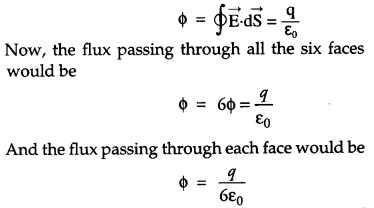
Question 9.
A test charge ‘q’ is moved without acceleration from A to C along the path from A to B and then from B to C in electric field E as shown in the figure,
(i) Calculate the potential difference between A and C.
(ii) At which point (of the two) is the electric potential more and why ? [2]
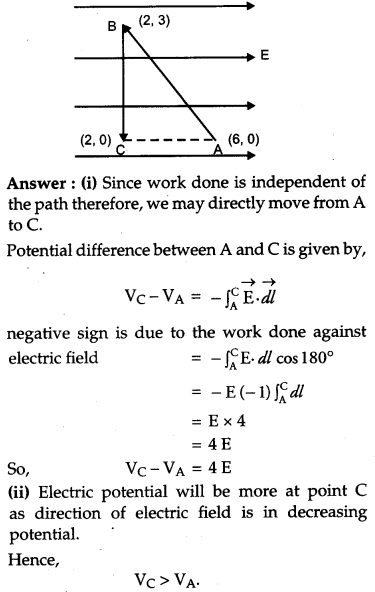
Question 10.
An electric dipole is held in a uniform electric field. [2]
(i) Show that the net force acting on it is zero.
(ii) The dipole is aligned parallel to the field. Find the work done in rotating it through the angle of 180°.
Answer:
(i) Consider an electric dipole consisting of two equal and opposite point charges, -q at A and +q at B, separated by a small distance 2a.
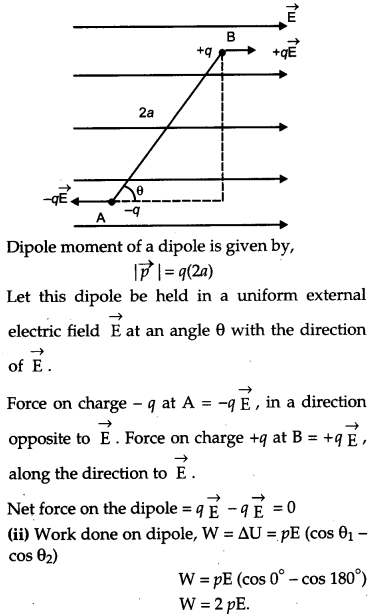
Question 11.
State the underlying principle of a transformer. How is the large scale transmission of electric energy over long distances done with the use of transformers ? [2]
Answer:
Transformer is a device which converts high voltage AC into low voltage AC and vice- versa. It is based on the principle of mutual induction. When alternating current is passed through a coil, an induced emf is set up in the neighboring coil.
Transformers are used for transmission of electrical energy over long distances. It step up the output voltage of power plant using step up transformer which reduces the current and increases the Voltage and hence reduces resistive power loss. Then a step down transformer is used at consumer end to step down the voltage and to increases the current.
Question 12.
A capacitor of capacitance ‘C’ is being charged by connecting it across a dc source along with an ammeter. Will the ammeter show a momentary deflection during the process of charging ? If so, how would you explain this momentary deflection and the resulting continuity of current in the circuit ? Write the expression for the current inside the capacitor. [2]
Answer :
Yes, the ammeter shows a momentary deflection during the process of charging because during charging, conduction current flows through the wires which leads to deposition of charges on the plates of capacitor. This produce an electric field of increasing magnitude, which in turn, produces a displacement currents between the plates and this displacement current maintains the continuity of current in the circuit.
Current inside the capacitor,
\(\mathrm{I}_{\mathrm{D}}=\varepsilon_{0} \frac{d \phi_{E}}{d t}\)
Question 13.
An object AB is kept in front of a concave mirror as shown in the figure. [2]
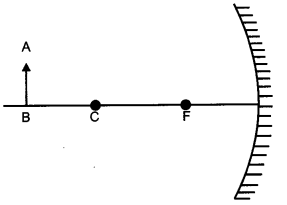
(i) Complete the ray diagram showing the image formation of the object.
(ii) How will the position and intensity of the image be affected if the lower half of the mirror’s reflecting surface is painted black ?
Answer:
(i)
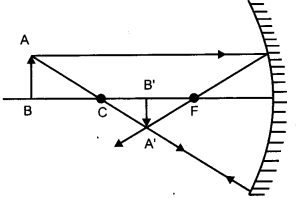
Image formed will real and inverted, between focus and center of curvature and small in size.
(ii) If the lower half of the mirror’s reflecting surface is painted black, the position of image will be same but its intensity gets reduced.
14. Draw a labelled ray diagram of a reflecting telescope. Mention its two advantages over the refracting telescope. [2]
Answer:
Reflecting Telescope :
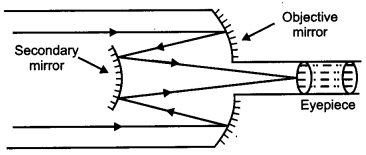
Advantages over refracting telescope :
- There is no chromatic aberration in reflecting telescope.
- The resolving power of a large aperture mirror is high and hence minute details of distant stars can be obtained.
Question 15.
Describe briefly with the help of a circuit diagram, how the flow of current carriers in a p-n-p transistor is regulated with emitter-base junction forward biased and base-collector junction reverse biased. [2]
Question 16.
In the given block diagram of a receiver, identify the boxes labelled as X and Y and write their functions. [2]
Question 17.
A light bulb is rated 100 W for 220 V ac supply of 50 Hz. Calculate : [2]
(i) The resistance of the bulb;
(ii) The rms current through the bulb.
OR
An alternative voltage given by V = 140 sin 314 t is connected across a pure resistor of 50 Ω. Find
(i) the frequency of the source.
(ii) the rms current through the resistor
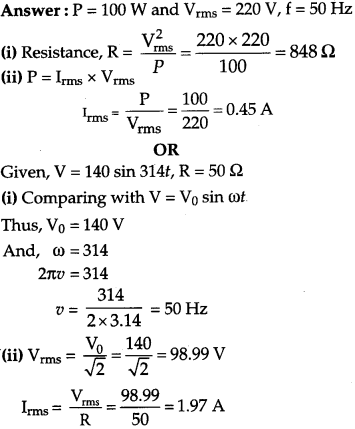
Question 18.
A circular coil of ‘N’ turns and radius ‘R’ carries a current ‘I’. It is unwound and rewound to make another coil of radius ‘R/2’, current T remaining the same. Calculate the ratio of the magnetic moments of the new coil and original coil. [2]
Answer :
The magnetic moment m of a current, carrying loop,
m = NIA
Where, N = number of turns.
Let m
1
and m
2
be the magnetic moments of circular original coil of radius ‘R’ and new coil of radius ‘R/2’.
Length of wire remains same. Thus,
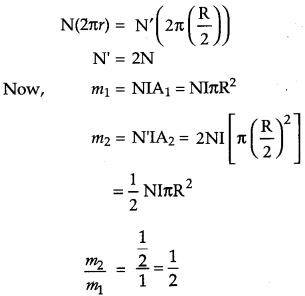
Question 19.
Deduce the expression for the electrostatic energy stored in a capacitor of capacitance ‘C’ and having charge ‘Q’. How will the
(i) energy stored and
(ii) the electric field inside the capacitor be affected when it is completely filled with a dielectric material of dielectric constant ‘K’ ? [3]
Answer :
Energy stored in a charged capacitor: The energy of a charged capacitor is measured by the total work done injharging the capacitor to a given potential. We know that, Capacitance,
\(\mathrm{C}=\frac{q}{\mathrm{V}}\)
Where q is the charge on the plates and V is potential difference. When an additional amount of charge dq is transferred from negative to positive plate, the small work done is given by
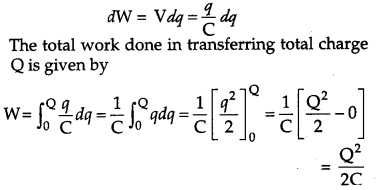
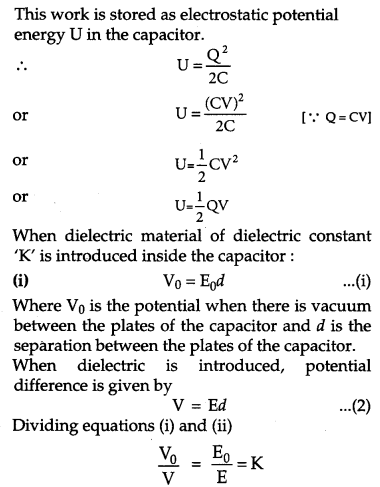
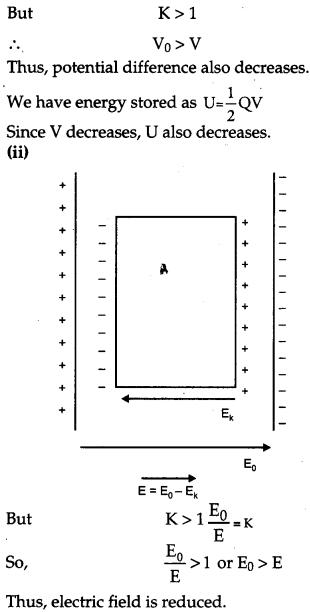
Question 20.
Calculate the value of the resistance R in the circuit shown in the figure so that the current in the circuit is 0.2 A. What would be the potential difference between points B and E ? [3]
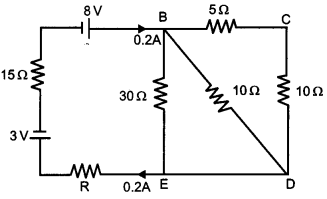
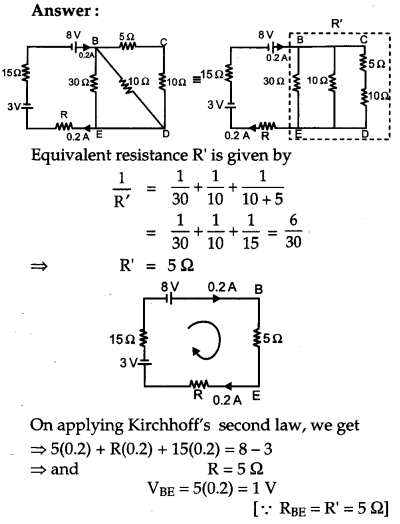
Question 21.
You are given three lenses L
1
, L
2
and L
3
each of focal length 20 cm. An object is kept at 40 cm in front of L
1
, as shown. The final real image is formed at the focus ‘I’ of L
3
. Find the separations between L
1
, L
2
and L
3
. [3]
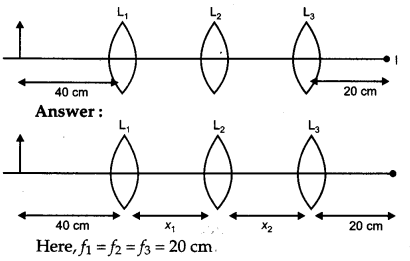
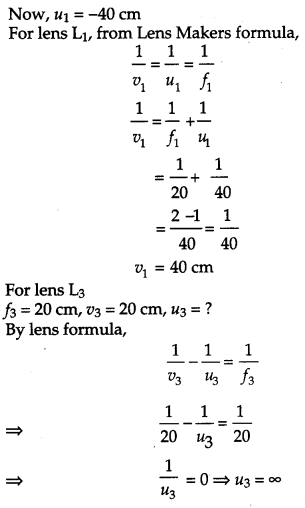
Thus lens L
2
should produce image at infinity. Hence, for L
2
, its object should be at focus.
But we have seen above that image by L
1
is formed at 40 cm on the right of L
1
which is at 20 cm left of L
2
(focus of L
2
).
So, X
1
= distance between L
1
and L
2
= (40 + 20) cm = 60 cm
Again distance between L
2
and L
3
does not matter as the image by L
2
is formed at infinity. Hence, the distance between L
2
and L
3
can have . any value.
Question 22.
Define the terms
(i) ‘cut-off voltage’ and
(ii) ‘threshold frequency’ in relation to the phenomenon of photoelectric effect.
Using Einstein’s photoelectric equation show how the cut-off voltage and threshold frequency for a given photosensitive material can be determined with the help of a suitable plot/graph. [3]
Answer:
When light of suitable frequency is incident on a metal surface, electrons are ejected from the metal. This phenomenon is called the photoelectric effect.
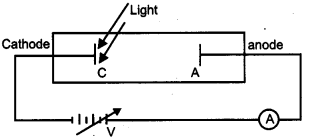
(i) The cathode is illuminated with light of some fixed frequency v and fixed intensity I
1
. A small photoelectric current is observed due to few electrons that reach anode just because they have sufficiently large velocity of emission. If we make the potential of the anode negative with respect to cathode then the electrons emitted by cathode are repelled. Some electrons even go back to the cathode so that the current decreases. At a certain value of this negative potential, the current is completely stopped. The least value of this anode potential which just stops the photo current is called cut off potential or stopping potential.
(ii) For a given material, there is a certain minimum frequency that if the incident radiation has a frequency below this threshold, no photoelectric emission will take place, howsoever intense the radiation may be falling. This minimum frequency is called threshold frequency.
According to Einstein’s photoelectric equation, maximum K.E. is given as
\(\mathrm{K.E}_{\max }=\frac{h c}{\lambda}-\phi=b v-\phi\)
Where λ is wavelength of light and v is corresponding frequency and Φ is work function. We expose a material to lights of various frequencies and thus photoelectric current is observed and cut off potential needed to reduce this current to zero is noted. A graph is plotted and that is straight line.
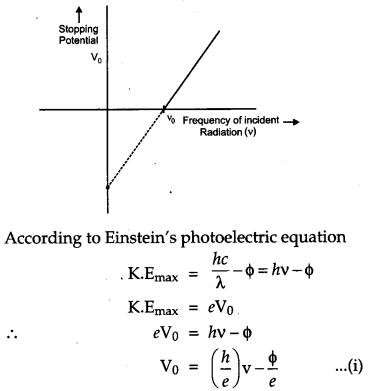
We can read the value of threshold frequency from graph.
From equation (i), we can find the value of stopping potential (V
0
).
Question 23.
A series LCR circuit is connected to an ac source. Using the phasor diagram, derive the expression for the impedance of the circuit. Plot a graph to show the variation of current with frequency of the source, explaining the nature of its variation.
[3]
Answer :
Let an alternating emf E = E
0
sin ωf is applied to a series combination of inductor L, capacitor C and resistance R. Since all three of them are connected in series the current through them is same. But the voltage across each element has a different phase relation with current.
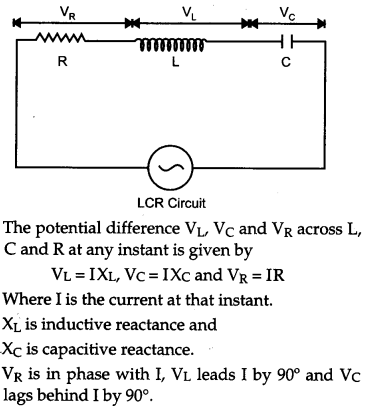
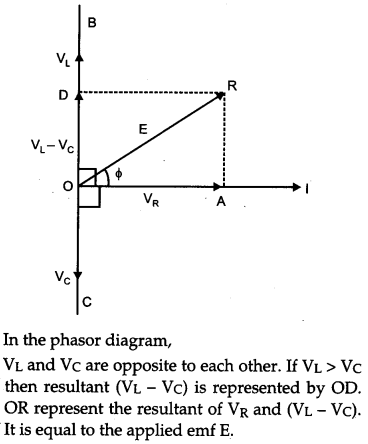
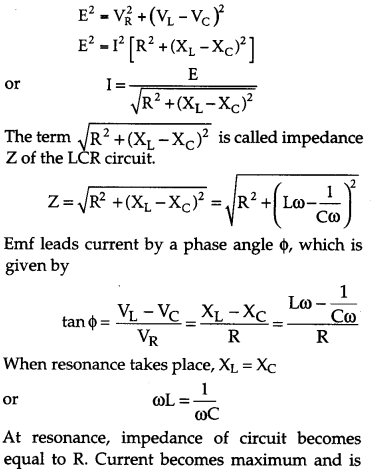
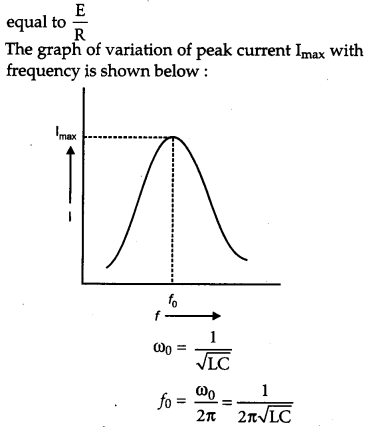
With increase in frequency, current first increases and then decreases. At resonant frequency, the current amplitude is maximum.
Question 24.
Mention three different modes of propagation used in communication system. Explain with the help of a diagram how long distance communication can be achieved by ionospheric reflection of radio waves. [3]
Question 25.
Draw a plot of potential energy of a pair of nucleons as a functions of their separations. Mark the regions where the nuclear force is
(i) attractive and
(ii) repulsive.
Write any two characteristic features of nuclear forces. [3]
Answer :
Potential energy of a pair of nucleons as a function of their separation :
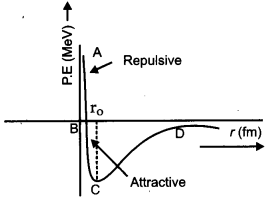
Here, Part AB represents repulsive force and part BCD represents attractive force. r0 is the distance at which potential energy is minimum.
Characteristic features of nuclear forces are :
- Nuclear forces are much stronger then Coulomb forces acting between charges or the gravitational forces between masses.
- The nuclear force between neutron- neutron, proton-neutron and proton-proton is approximately the same. The nuclear force does not depend on the electric charge.
Question 26.
In a Geiger-Marsden experiment, calculate the distance of closest approach to the nucleus of Z = 80, when α-particle of 8 MeV energy impinges on it before it comes momentarily to rest and reverses its direction.
How will the distance of closest approach be affected when the kinetic energy of the a-particle is doubled ? [3]
OR
The ground state energy of hydrogen atom is -13.6 eV. If an electron makes a transition from an energy level -0.85 eV to -3.4 eV, calculate the wavelength of the spectral line emitted. To which series of hydrogen spectrum does the wavelength belong ?
Answer :
Let ro be the centre to centre distance between the alpha-particle and nucleus.
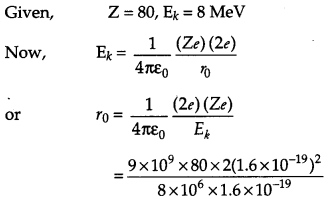
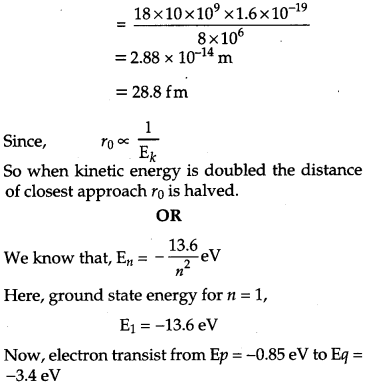
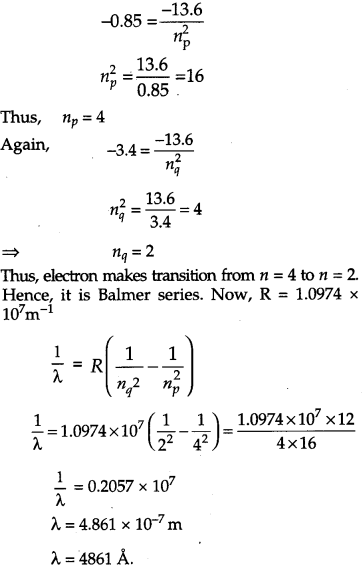
Question 27.
Define relaxation time of the free electrons drifting in a conductor. How is it related to the drift velocity of free electrons ? Use this relation to deduce the expression for the electrical resistivity of the material. [3]
Answer:
Relaxation time (T) is the time for which a free electron accelerates before it undergoes a collision with the positive ion in the conductor. Or, we can say it is the average time elapsed between two successive collisions. It is of the order 10-14 seconds. It decreases with increase of temperature and is given as
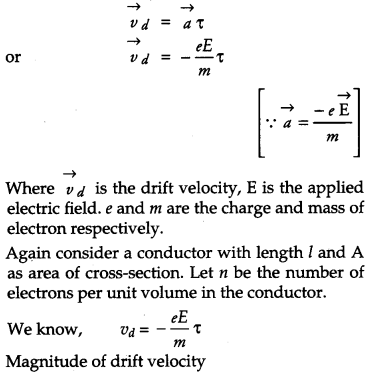
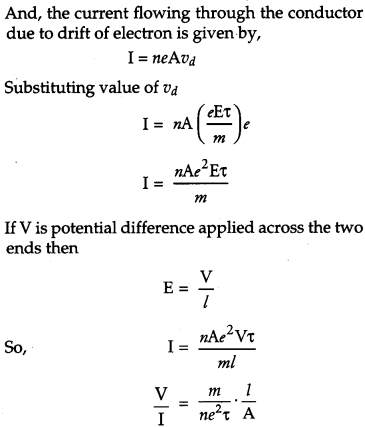
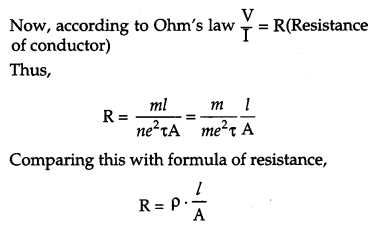

Question 28.
(a) In Young’s double slit experiment, derive the condition for
(i) constructive interference and
(ii) destructive interference at a point on the screen.
(b)A beam of light consisting of two wavelengths, 800 nm and 600 nm is used to obtain the interference fringes in a Young’s double slit experiment on a screen placed 1.4 m away. If the two slits are separated by 0.28 mm, calculate the least distance from the central bright maximum where the bright fringes of the two wavelengths coincide. [5]
OR
(a) How does an unpolarized light incident on a Polaroid get polarized ? Describe briefly, with the help of a necessary diagram, the polarization of light by reflection from a transparent medium.
(b) Two Polaroids ‘A’ and ‘B’ are kept in crossed position. How should a third Polaroid ‘C’ be placed between them so that the intensity of polarized light transmitted by Polaroid B reduces to l/8th of the intensity of unpolarized light incident on A ?
Answer :
(a) Condition of constructive and destructive interference:
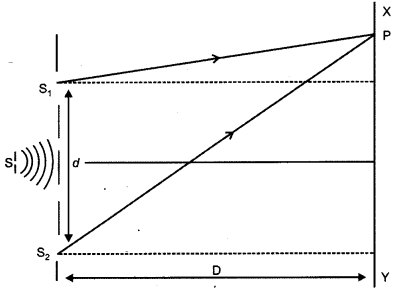
In the given figure, S is a monochromatic source of light. S
1
and S
2
are two narrow pin holes equidistant from S and they act as coherent sources. Consider a point P on the screen XY placed parallel to S
1
and S
2
.
Let a
1
be the amplitude of the waves from S
1
and a
2
is from S
2
. Let Φ be the phase difference between the two waves reaching the point P. Let y
1
and y
2
be the displacements of the two waves,
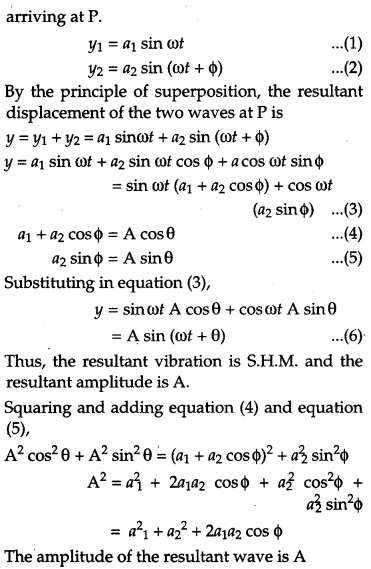
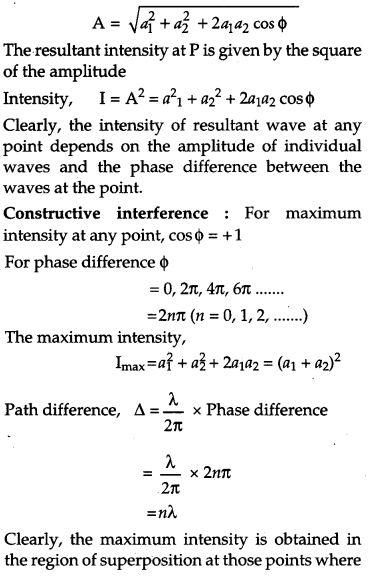
waves meet in the same phase or the phase difference between the waves is even multiple of π or path difference between them is the integral multiple of λ and maximum intensity is (a
1
+ a
2
)
2
which is greater than the sum intensities of individual waves by an amount 2a
1
a
2
.
Destructive interference : For minimum intensity at any point, cosΦ = -1.
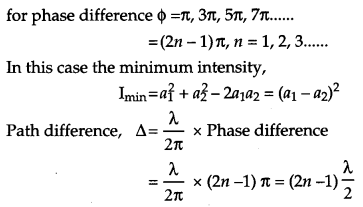
Clearly, the minimum intensity is obtained in the region of superposition at those points where waves meet in opposite phase or the phase difference between the waves is odd multiple of π or path difference between the waves is odd
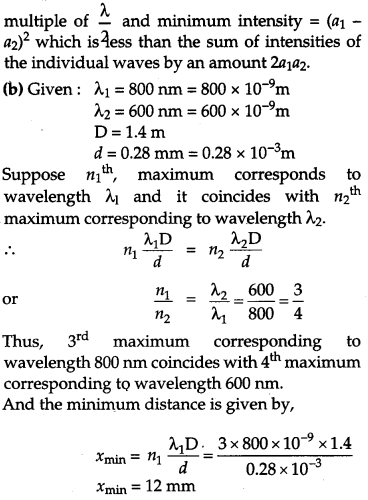
OR
(a) Polaroid is made up of a special material which blocks one of the two planes of vibration of an electromagnetic wave. Because of its chemical composition, it allows only those vibrations of the electromagnetic wave which are parallel to its crystallographic axis.
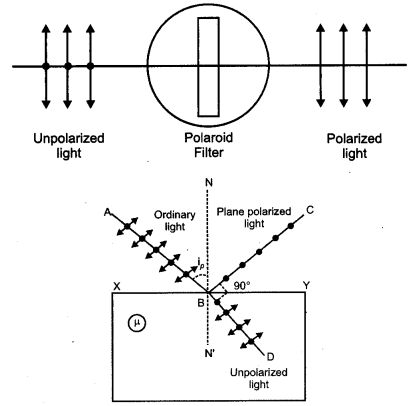
An ordinary beam of light on reflection from a transparent medium becomes partially polarized. The degree of polarization increases as the angle of incidence is increased. At a particular value of angle of incidence, the reflected beam becomes completely polarized. This angle of incidence is called the polarizing angle (i
P
).
(b) By Malus law, the intensity of light emerging from the middle polaroid ‘C’ is given by
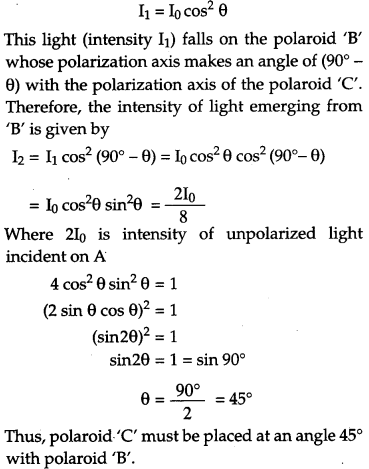
Question 29.
(a) Describe briefly, with the help of a diagram, the role of the two important processes involved in the formation of a p-n junction.
(b) Name the device which is used as a voltage regulator. Draw the necessary circuit diagram and explain its working. [5]
OR
(a) Explain briefly the principle on which a transistor-amplifier works as an oscillator. Draw the necessary circuit diagram and explain its working.
(b) Identify the equivalent gate for the following circuit and write its truth table.
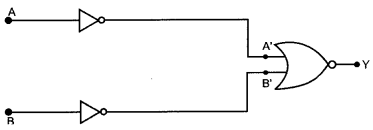
Answer :
(a) Two important process involved in the formation of a p-n junction are
(i) diffusion and
(ii) drift.
In n-type semiconductor, electrons are the majority carriers and holes are minority carriers. In the same way, in p-type semiconductor holes are majority and electrons are minority carriers. During the formation of p-n junction, due to concentration gradient, the holes diffuse from p side to n side and electrons diffuse from n side to p side. This motion gives rise to diffusion current across the junction.
When an electron diffuses from n to p side, it leaves behind a positive charge. In such a manner a positively charged layer forms on n-side of the junction.
Similarly, when a hole diffuses from p to n side, it leaves behind a negative charge and a negatively charged layer forms on p side of the junction.
This space charge region is known as depletion region. An electric field directed from n-region to p-region develops across the junction. Due to this field, electrons on p side of the junction move to n-side and holes on n side of the junction move to p side. This motion of charge carriers due to the electric field is called drift.
Drift current is opposite in direction to the diffusion current. Initially, diffusion current is large and drift current is small. Space-charge region on either side increases as the diffusion process continues. This increases the electric field and hence the drift current. This process continues until the diffusion current equals the drift current.
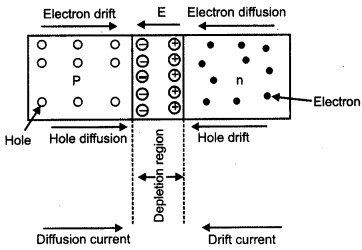
(b) Zener diode is used as a voltage regulator.
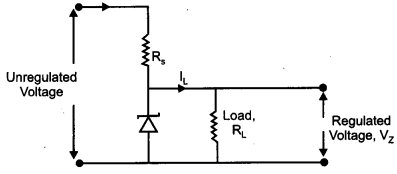
Voltage regulator converts an unregulated dc voltage into a constant regulated dc voltage using zener diode. The unregulated voltage is connected to the zener diode through a series resistance Rs such that the zener diode is reverse biased. If the input voltage increases, the current through Rs and zener diode also increases. This increases the voltage drop across Rs without any change in voltage drop across zener diode. This is because in the breakdown region, zener voltage remain constant even though the current through zener diode changes.
Similarly, if the input voltage decreases, the current through Rs and zener diode decrease. The voltage drop across R§ decrease without any change in the voltage across the zener diode. Thus any change in input voltage results the change in voltage drop across Rs without any change in voltage across the zener diode.
Question 30.
(a) Write the expression for the force \(\overrightarrow{\mathbf{F}}\), acting on a charged particle of charge ‘q’, moving with a velocity \(\overrightarrow{\mathbf{v}}\) in the presence of both electric field \(\overrightarrow{\mathbf{E}}\) and magnetic field \(\overrightarrow{\mathbf{B}}\) . Obtain the condition under which the particle moves undeflected through the fields.
(b) A rectangular loop of size 1 × b carrying a steady current I is placed in a uniform magnetic field \(\overrightarrow{\mathbf{B}}\) Prove that the torque \(\overrightarrow{\mathbf{T}}\) acting on the loop is given by, \(\overrightarrow{\mathbf{T}}\)= \(\overrightarrow{\mathbf{m}}\) × \(\overrightarrow{\mathbf{B}}\) where in is the magnetic moment of the loop.[5]
OR
(a) Explain giving reasons, the basic difference in converting a galvanometer into
(i) a voltmeter and
(ii) an ammeter.
(b) Two long straight parallel conductors carrying steady currents I
1
and I
2
are separated by a distance’d’. Explain briefly, with the help of a suitable diagram, how the magnetic field due to one conductor acts on the other. Hence deduce the expression for the force acting between the two conductors. Mention the nature of this force.
Answer:
(a) Force acting on a charge ‘q’ moving with velocity \(\overrightarrow{\mathbf{v}}\) in the presence of both electric field \(\overrightarrow{\mathbf{E}}\) and magnetic field \(\overrightarrow{\mathbf{B}}\) is given by,
\(\overrightarrow{\mathrm{F}}=q \overrightarrow{\mathrm{E}}+q(\vec{v} \times \overrightarrow{\mathrm{B}})\)
Consider a region in which magnetic field, electric field and velocity of charge particle are perpendicular to each other.
To move charge particle undeflected, the net force acting on the particle must be zero i.e., the electric force must be equal and opposite to the magnetic force.
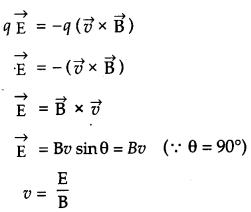
The direction of electric and magnetic forces are in opposite direction. Their magnitudes are in such a way that they cancel out each other to give net force zero and so the charge particle does not deflect
(b) When an electric current flows in closed loop of wire, placed in a uniform magnetic field, the magnetic forces produce a torque which
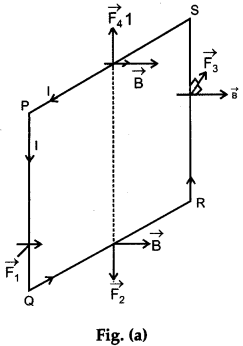
tends to rotate the loop so that area of the loop is perpendicular to the direction of the magnetic field.
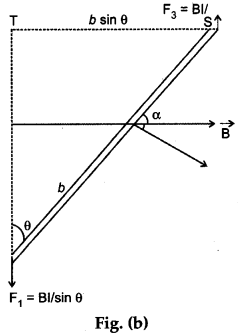
Consider a rectangular coil PQRS placed in an external magnetic field as shown in Fig (a). Let ‘I’ be the current flowing through the coil. Each part of the coil experiences a Lorentz force. Forces of each part is \(\overrightarrow{\mathrm{F}_{1}}\), \(\overrightarrow{\mathrm{F}_{2}}\), \(\overrightarrow{\mathrm{F}_{3}}\) and \(\overrightarrow{\mathrm{F}_{4}}\) as shown. The \(\overrightarrow{\mathrm{F}_{4}}\) and \(\overrightarrow{\mathrm{F}_{2}}\) are equal in magnitude but act in opposite directions along the same straight line. Hence, they cancel out each other.
\(\sqrt { 4 } \)

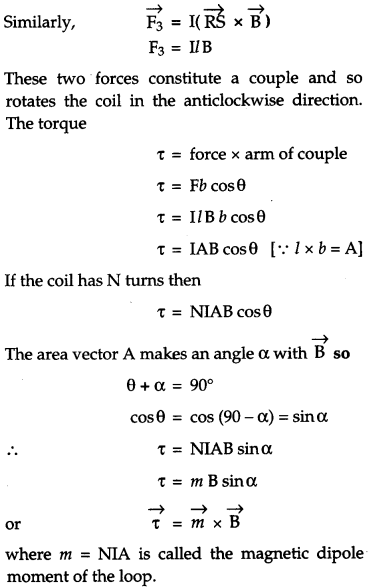
OR
(a) (i) In converting a galvanometer into a voltmeter, a very high suitable resistance is connected in series to its coil, so, that galvanometer gives full scale deflection.
(ii) In converting a galvanometer into an ammeter, a very small suitable resistance is connected in parallel to its coil. The remaining pair of the current i.e., (I – I
g
) flows through the resistance.
(b) Assumption : Current flowing in the conductors are in the same direction. Using right hand thumb rule, the direction of the magnetic field at point P due to current I
2
is perpendicular to the plane of paper and inwards.
Similarly, at point Q on X
2
Y
2
, the direction of magnetic field due to current Ii is perpendicularly outward. Using Fleming’s left hand rule we can find the direction of forces F
12
and F
21
which are in opposite directions,
Thus, by Ampere’s circuital law, we have,
From above we get the magnitude of forces F
12
and F
21
are equal but in opposite direction. So,
F
12
= – F
21
Therefore, two parallel straight conducting carrying current in the same direction attract each other. Similarly, we can prove if two parallel straight conductors carry currents in opposite direction, they repel each other with the same magnitude as equation (i).
CBSE Previous Year Question Papers Class 12 Physics 2012 Outside Delhi Set-II
Note : Except for the following questions, all the remaining questions have been asked in previous Set
Question 1.
In a single-slit diffraction experiment, the width of the slit is made double the original width. How does this affect the size and intensity of the central diffraction band ? [1]
Answer :
In single-slit diffraction experiment, fringe width is given as
\(\beta=\frac{2 \pi \mathrm{D}}{d}\)
Where, β = fringe width
λ = wavelength of light used
D = the distance between screen and slit
d = the width of the slit.
If d is doubled, the width of the central maximum is halved. Thus there is a reduction in the size of the central diffraction band. Intensity of central band of the diffraction pattern varies square of the slit width so as the slit gets double, intensity will get four times.
Question 2.
You are given three lens L
1
, L
2
, L
3
each of focal length 15 cm. An object is kept at 20 cm in front of L
1
, as shown. The final real image is formed at the focus T of L
3
. Find the separations between L
1
, L
2
and L
3
. [3]
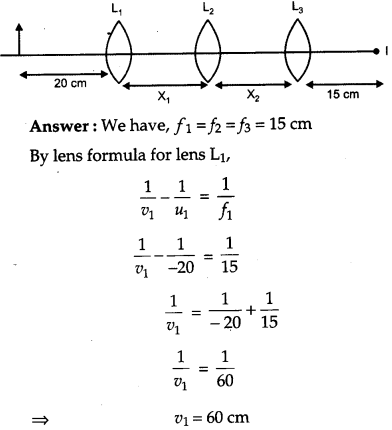
For lens L
3
, v
3
=f
3
= 15 cm, it means image by L
3
is formed at focus. By using lens formula we find that the object lie at infinity of L
3
. Hence, L
2
will produce image at infinity. So, we can conclude that object for L
2
should be at its focus.
But, we have seen above the image by L
1
is formed at 60 cm right of L
1
which is at 15 cm left of L
2
(focus of L
2
).
So, X
1
= distance between L
1
and L
2
= (60 + 15) cm = 75 cm Again distance between L
2
and L
3
does not matter as the image by L
2
is formed at infinity so X
2
can take any value.
Question 3.
In a Geiger Marsden experiment, calculate the distance of closest approach to the nucleus of Z = 75, when an particle of 5 MeV energy impinges on it before it comes momentarily to rest and reverse its direction.
How will the distance of closest approach be affected when the kinetic energy of the-particle is doubled ? [3]
OR
The ground state energy of hydrogen atom is -13.6 eV. If an electron make a transition from an energy level -0.85 eV to -1.51 eV, calculate the wavelength of the spectral line emitted. To which series of hydrogen spectrum does this wavelength belong ?
Answer :
Let ro be the centre to centre distance between the α-particle and nucleus when the a-particle is at its stopping point.
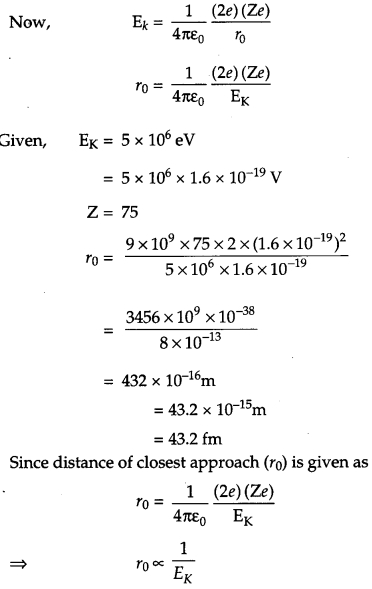
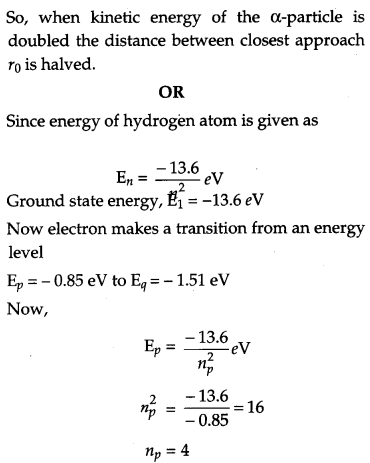
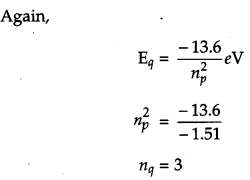
Thus, we have transition from n = 4 to n = 3.
Since transition corresponds to the transition of an electron from n = 4 to an orbit having n = 3. It is Paschen series of the hydrogen spectrum. Wavelength is given as
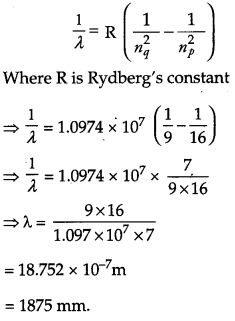
CBSE Previous Year Question Papers Class 12 Physics 2012 Outside Delhi Set-III
Note : Except for the following questions, all the remaining questions have been asked in previous Sets.
Question 1.
How does the fringe width, in Young’s double¬slit experiment change when the distance of separation between the slits and screen is doubled ? [1]
Answer:
We have, frings width

The fringe width becomes double when the distance of separation between the slits and screen is doubled
Question 2.
The speed of an electromagnetic wave in a material medium is given by \(v=\frac{1}{\sqrt{\mu \varepsilon}}, \mu\) being the permeability of the medium and ∈ is its permittivity. How does its frequency change ? [1]
Answer :
The frequencies of electromagnetic waves have its inherent characteristics. When an electromagnetic wave travels from one medium to another, its wavelength changes but frequency remains unchanged.
Question 3.
A proton and an electron have same kinetic energy. Which one has smaller de-Broglie wavelength and why ? [1]
Answer :
In terms of kinetic energy, wavelength is given by

So wavelength is inversely proportional to √m, i.e., more the mass, less the wavelength and vice- versa.
So, for same kinetic energy, as a proton has a larger mass than an electron, thus a proton has smaller de-Broglie wavelength than a electron.
Question 4.
A circular coil of closely wound N turns and radius r carries a current I. Write the expression for the following: [2]
(i) the magnetic field at its center
(ii) the magnetic moment of this coil
Answer :
(i) Magnetic field at its centre is given

(ii) Magnetic moment of this coil is
![]()
Question 5.
A light bulb is rated 150 W for 220 V a.c supply of 60 Hz. Calculate [2]
(i) the resistance of the bulb
(ii) the rms current through the bulb
OR
An alternating voltage given by V = 70 sin 100πt is connected across a pure resistor of 25 Ω. Find
(i) the frequency of the source.
(ii) the rms current through the resistor.
Answer:
(i) Resistance of the bulb,
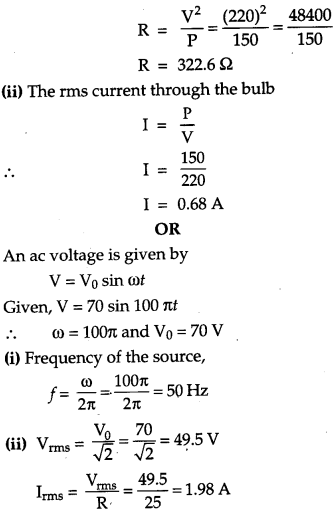
Question 6.
Explain briefly the following terms used in communication system : [3]
(i) Transducer
(ii) Repeater
(iii) Amplification
Question 7.
You are given three lens L
1
, L
2
and L
3
each of focal length 10 cm. An object is kept at 15 cm in front of L
1
, as shown. The final real image is formed at the focus T of L
3
. Find the separations between L
1
, L
2
and L
3
.
For lens L 3 , V 3 = f 3 = 10 cm, it means image by L 3 is formed at focus. So by using lens formula, we get that object should lie at infinity for L 3 . Hence, L 2 will produce image at infinity. So, we can conclude that object for L 2 should be at its focus.
But, we have seen above that image by Li is formed at 30 cm right of L
1
which is at 10 cm left of L
2
(focus of L
2
).
So, X
1
= distance between L
1
and L
2
= (30 + 10) cm 40 cm. Again distance between L
2
and L
3
does not matter as the image by L
2
is formed at infinity so X
2
can take any value.